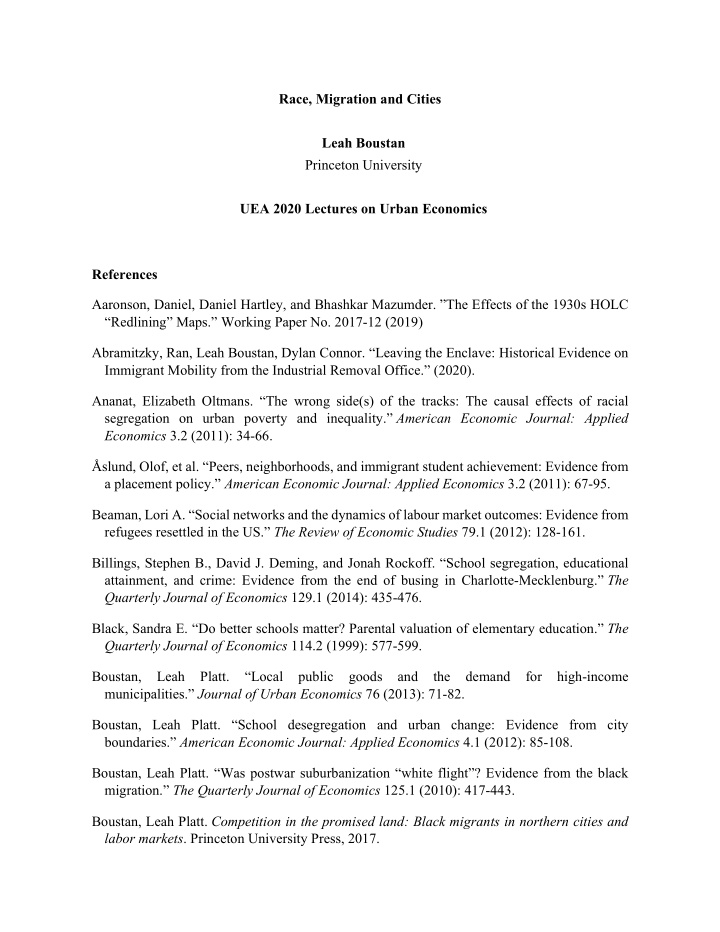



Race, Migration and Cities Leah Boustan Princeton University UEA 2020 Lectures on Urban Economics References Aaronson, Daniel, Daniel Hartley, and Bhashkar Mazumder. ”The Effects of the 1930s HOLC “Redlining” Maps.” Working Paper No. 2017-12 (2019) Abramitzky, Ran, Leah Boustan, Dylan Connor. “Leaving the Enclave: Historical Evidence on Immigrant Mobility from the Industrial Removal Office.” (2020). Ananat, Elizabeth Oltmans. “The wrong side(s) of the tracks: The causal effects of racial segregation on urban poverty and inequality.” American Economic Journal: Applied Economics 3.2 (2011): 34-66. Åslund, Olof, et al. “Peers, neighborhoods, and immigrant student achievement: Evidence from a placement policy.” American Economic Journal: Applied Economics 3.2 (2011): 67-95. Beaman, Lori A. “Social networks and the dynamics of labour market outcomes: Evidence from refugees resettled in the US.” The Review of Economic Studies 79.1 (2012): 128-161. Billings, Stephen B., David J. Deming, and Jonah Rockoff. “School segregation, educational attainment, and crime: Evidence from the end of busing in Charlotte-Mecklenburg.” The Quarterly Journal of Economics 129.1 (2014): 435-476. Black, Sandra E. “Do better schools matter? Parental valuation of elementary education.” The Quarterly Journal of Economics 114.2 (1999): 577-599. Boustan, Leah Platt. “Local public goods and the demand for high-income municipalities.” Journal of Urban Economics 76 (2013): 71-82. Boustan, Leah Platt. “School desegregation and urban change: Evidence from city boundaries.” American Economic Journal: Applied Economics 4.1 (2012): 85-108. Boustan, Leah Platt. “Was postwar suburbanization “white flight”? Evidence from the black migration.” The Quarterly Journal of Economics 125.1 (2010): 417-443. Boustan, Leah Platt. Competition in the promised land: Black migrants in northern cities and labor markets . Princeton University Press, 2017.
Boustan, Leah. “Racial Residential Segregation in American Cities,” in Oxford Handbook of Urban Economics and Planning, ed. Nancy Brooks and Gerrit-Jan Knaap (Oxford University Press, 2011), 318–39. Cascio, Elizabeth U., and Ethan G. Lewis. “Cracks in the melting pot: immigration, school choice, and segregation.” American Economic Journal: Economic Policy 4.3 (2012): 91-117. Chyn, Eric. “Moved to opportunity: The long-run effects of public housing demolition on children.” American Economic Review 108.10 (2018): 3028-56. Collins, William J. “The housing market impact of state-level anti-discrimination laws, 1960– 1970.” Journal of Urban Economics , 55(3), 2004, 534-564. Collins, William J., and Katharine L. Shester. “Slum clearance and urban renewal in the United States.” American Economic Journal: Applied Economics 5.1 (2013): 239-73. Connor, Dylan Shane, et al. “How Entrenched Is the Spatial Structure of Inequality in Cities? Evidence from the Integration of Census and Housing Data for Denver from 1940 to 2016.” Annals of the American Association of Geographers (2019): 1-18. Cutler, David M., and Edward L. Glaeser. “Are ghettos good or bad?.” The Quarterly Journal of Economics 112.3 (1997): 827-872. Cutler, David M., Edward L. Glaeser, and Jacob L. Vigdor. “The rise and decline of the American ghetto.” Journal of political economy 107.3 (1999): 455-506. Derenoncourt, Ellora. “Can you move to opportunity: Evidence from the Great Migration.” Working Paper (2019). Edin, Per-Anders, Peter Fredriksson, and Olof Åslund. “Ethnic Enclaves and the Economic Success of Immigrants—Evidence from a Natural Experiment.” Quarterly Journal of Economics , 118:1 (2003), 329–357, Glaeser, Edward, and Jacob Vigdor. “The end of the segregated century.” Manhattan Institute for Policy Research, (2012): 23-26. Gregory, James N. The southern diaspora: How the great migrations of black and white southerners transformed America . Univ of North Carolina Press, 2006. Ihlanfeldt, Keith R., and Benjamin Scafidi. “Black self-segregation as a cause of housing segregation: Evidence from the multi-city study of urban inequality.” Journal of Urban Economics 51.2 (2002): 366-390. Johnson, Rucker C. “Long-run Impacts of School Desegregation and School Quality on Adult Attainments.” National Bureau of Economic Research, No. w16664. 2011.
Jones-Correa, Michael. “The origins and diffusion of racial restrictive covenants.” Political Science Quarterly 115.4 (2000): 541-568. Krysan, Maria, and Reynolds Farley. “The Residential Preferences of Blacks: Do They Explain Persistent Segregation?.” Social Forces 80.3 (2002): 937-980. Logan, Trevon D., and John M. Parman. “The National Rise in Residential Segregation.” Journal of Economic History 77.1 (2017): 127-170. Ran Abramitzky, Leah Boustan and Myera Rashid. Census Linking Project: Version 1.0 [dataset]. 2020. https://censuslinkingproject.org Shertzer, Allison, and Randall P. Walsh. “Racial sorting and the emergence of segregation in American cities.” Review of Economics and Statistics 101.3 (2019): 415-427. Tach, Laura, and Allison Dwyer Emory. “Public housing redevelopment, neighborhood change, and the restructuring of urban inequality.” American journal of sociology 123.3 (2017): 686- 739. Taylor, Keeanga-Yamahtta. Race for Profit: How Banks and the Real Estate Industry Undermined Black Homeownership . University of North Carolina Press, 2019. Tuttle, Cody. “The Long-run Economic Effects of School Desegregation.” Available at SSRN 3460993 (2019).
Recommend
More recommend